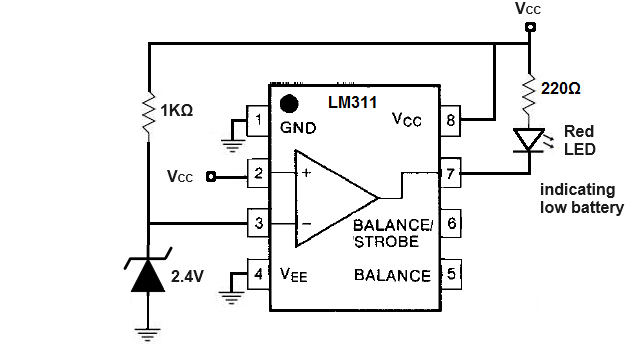How to Add a Low Battery Indicator Circuit to a Product for Less than $1

In this article, we show how adding a low battery indicator circuit to an electronic product can be done for less than $1 in cost.
A low battery indicator serves to tell a user of a product when the battery is low, so that the user can either change or recharge the battery.
Not having this in your product can be bad for the user, because otherwise, the user will never know when the battery is low. Thus, obviously, it's very useful.
So, in order to build a low battery indicator circuit, we can use the basic circuit shown below.

So we can see that we have an IC, the LM311 comparator chip.
We see there is a 2.4v rated zener diode.
We see a 1KΩ resistor and a 220Ω resistor.
We then see a red LED.
This is really all that we need to build a circuit that will turn on a red LED when the voltage in the circuit goes low (below 2.4v).
Now let's go over how much it would cost you to add this circuit to an electronic product.
It may surprise you just how cheap it is to do so, so it will not add much cost to a circuit but adds tremendous utility. The user will now know when the battery is low.
So to do this, we use a electronics parts supplier online, Tayda Electronics.
As of the time of the creation of this webpage (2/21/2024), the parts have the following cost on the website.
The LM311 comparator circuit costs $0.23.

The zener diode, which is an 1N5221B zener diode costs $0.05.

The 1KΩ resistor costs less than $0.02.

The 220Ω resistor costs less than $0.02.

The red LED costs $0.02.

So, adding up all the components, we have a grand total of $0.23 + $0.05 + $0.02 + $0.02 + $0.02 = $0.34
$0.34 is all that is required to add a low battery indicator to your circuit.
That is a very low cost.
So it barely adds any cost to the product but much usefulness.
A greater worry than the cost is probably the space that a circuit like this takes up on a product. For certain products, this may be a nonfactor but for other products, this may be something very difficult to add.
But the basic purpose of this article is to show the simplicity and low cost associated with a circuit like this.
Very few components are needed to create a battery indicator and if less than $0.50 is not a problem for additional cost to a product
and real estate is not a problem, this is something that should be added to an electronic product.
Related Resources
